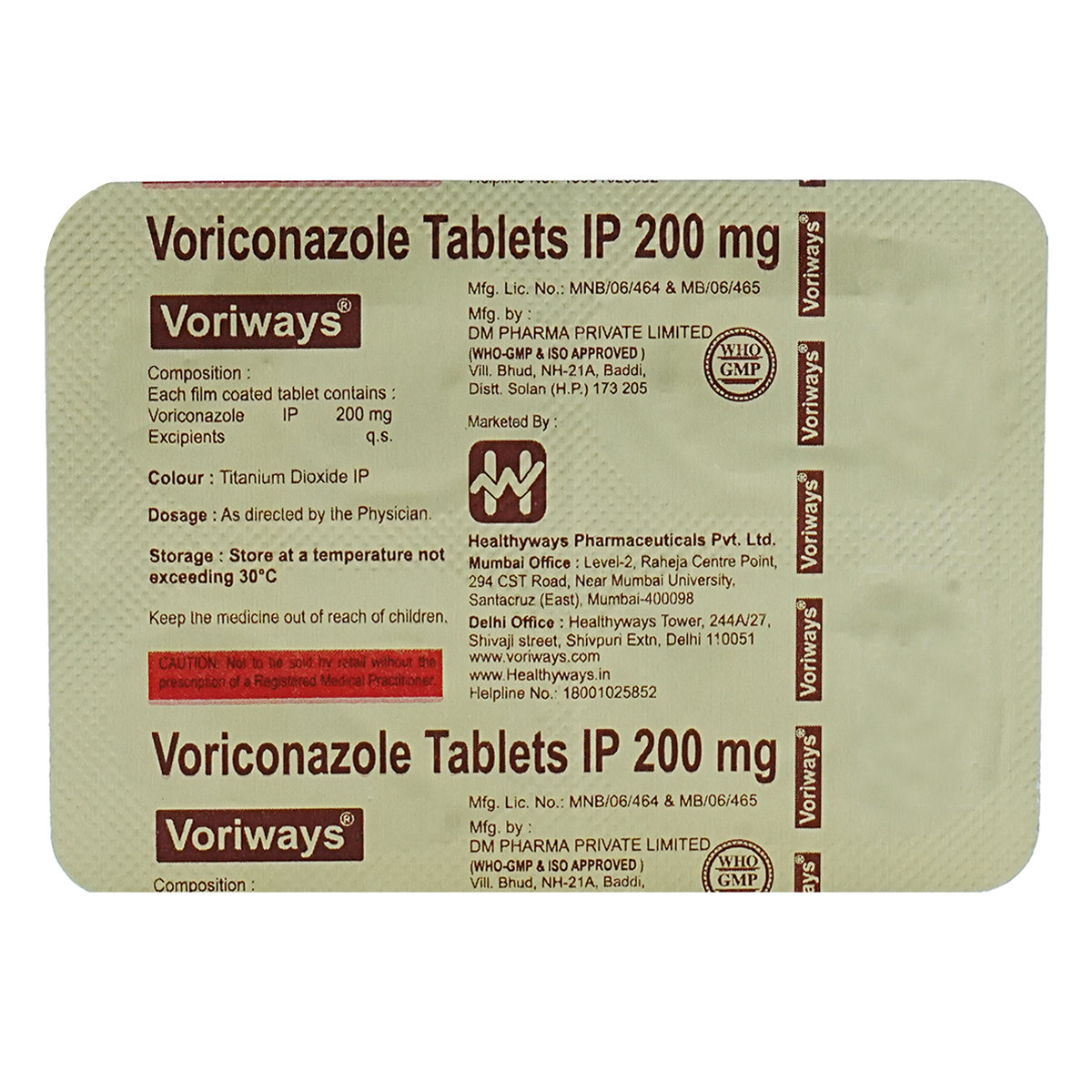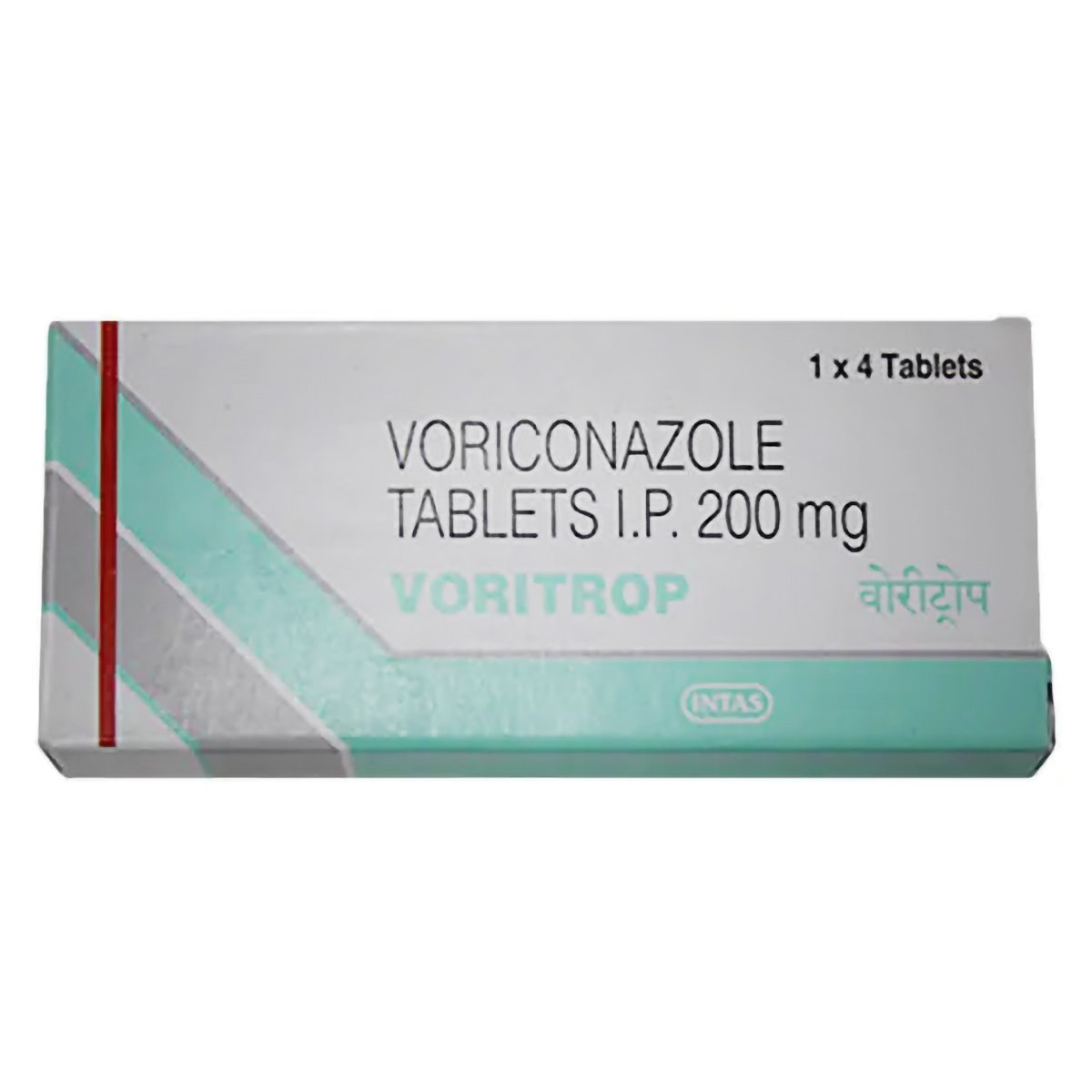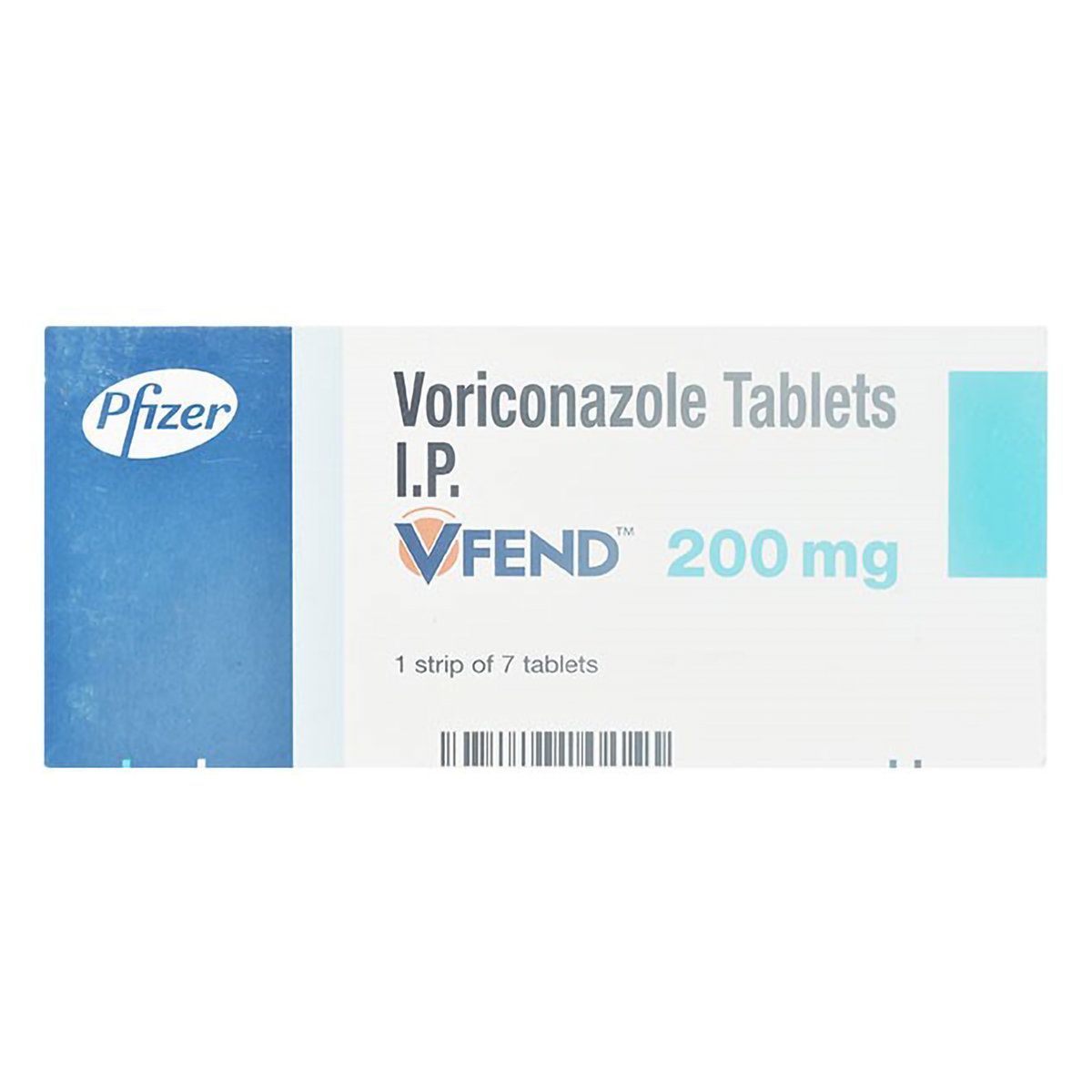Voritrol 200 Tablet






MRP ₹2618.5
(Inclusive of all Taxes)
₹392.8 Cashback (15%)
know your delivery time
Provide Delivery Location
Composition :
Manufacturer/Marketer :
Consume Type :
Expires on or after :
Return Policy :

Secure Payment

Trusted by 8 Crore Indians

Genuine Products
Therapeutic Class
Country of origin
Manufacturer/Marketer address
Disclaimer
Alcohol
Safe if prescribed
It is advisable to avoid or limit the intake of alcohol while you use Voritrol 200 Tablet.
Pregnancy
Consult your doctor
It is unsafe to take Voritrol 200 Tablet during pregnancy since it may show harmful effects on the fetus as it is a pregnancy category D drug. There are chances of spontaneous abortions in women treated with Voritrol 200 Tablet in the first trimester. Consult your doctor for further advice.
Breast Feeding
Consult your doctor
If you are breastfeeding, please consult your doctor before taking Voritrol 200 Tablet. Your doctor may prescribe this medicine if the benefits outweigh the risks.
Driving
Safe if prescribed
Do not drive or operate machines if you experience dizziness or sensitivity to sunlight after taking Voritrol 200 Tablet.
Liver
Consult your doctor
Inform your doctor if you have liver problems before taking Voritrol 200 Tablet. Your doctor may adjust the dose if necessary based on your condition.
Kidney
Consult your doctor
Inform your doctor if you have kidney problems before taking Voritrol 200 Tablet. Your doctor may adjust the dose if necessary based on your condition.
Children
Safe if prescribed
Please consult your doctor. Your doctor will prescribe Voritrol 200 Tablet based on the age, condition and body weight of your child.
Product Substitutes
About Voritrol 200 Tablet
Voritrol 200 Tablet belongs to the class of medicines known as 'antifungals' used to treat a broad range of infections caused due to fungi and yeast. A fungal infection is caused when a fungus invades and affects any part of the body, including the mouth, throat, esophagus, lungs, bladder, genital area and blood.
Voritrol 200 Tablet contains ‘Voriconazole’ that kills or prevents fungi or yeast by inhibiting an enzyme in fungi responsible for its normal fat metabolism, which interferes with the fungal cell membrane's formation. As a result, fungal or yeast cells get killed, or their growth is minimized.
Take Voritrol 200 Tablet as prescribed by your doctor. You are advised to take Voritrol 200 Tablet for as long as your doctor has prescribed it for you, depending upon your medical condition. In some cases, you may experience certain common side effects such as vomiting, headache, nausea, abnormal liver function tests, rash, slow heart rate, and altered vision. Most of these side effects do not require medical attention and will resolve gradually over time. However, you are advised to talk to your doctor if you experience these side effects persistently.
Do not take Voritrol 200 Tablet if you have had an allergic reaction Voritrol 200 Tablet or any of its ingredients. Voritrol 200 Tablet is associated with liver toxicity, including fatalities in patients with other serious underlying diseases. Voritrol 200 Tablet is a pregnancy category D drug, so it should not be taken by breastfeeding and pregnant women. Exposure to sunlight should be avoided while taking $Name as it makes you sensitive to the sun's UV rays or use a high sun protection factor (SPF) while going out. Antacid should be taken at 2 hours after taking Voritrol 200 Tablet.
Uses of Voritrol 200 Tablet
Medicinal Benefits Mweb
Key Benefits
Voritrol 200 Tablet belongs to the class of medicines known as 'antifungal' containing Voriconazole, used to treat a broad range of infections caused due to fungi and yeast. It treats various fungal infections like invasive aspergillosis (fungal infection in the lungs), esophageal candidiasis (white patching in the mouth and throat) and candidemia (a fungal infection in the blood). It is also used to treat certain fungal infections when other medications do not work for certain patients. It works by killing or preventing fungi or yeast by inhibiting an enzyme in fungi responsible for its normal fat metabolism, interfering with the fungal cell membrane's formation. As a result, fungal or yeast cells get killed, or their growth is minimized.
Directions for Use
Side Effects of Voritrol 200 Tablet
- Vomiting
- Headache
- Nausea
- Abnormal liver function tests
- Rash
- Sinus infections
- Low numbers of white and red blood cells
- Slow heart rate
- Altered vision
- Low blood sugar
- Depression, hallucinations
Drug Warnings
Do not take Voritrol 200 Tablet if you have had an allergic reaction Voritrol 200 Tablet or any of its ingredients. Voritrol 200 Tablet is associated with liver toxicity, including fatalities in patients with other serious underlying diseases. If you are suffering from liver disease, the doctor will lower the dose, and a regular liver function test will be done. Voritrol 200 Tablet is a pregnancy category D drug, so it should not be taken in breastfeeding and pregnant women. If you are suffering from a heart problem like an irregular heartbeat, slow heart rate or abnormality in ECG (electrocardiogram), please inform your doctor before starting Voritrol 200 Tablet. Exposure to sunlight should be avoided while taking $Name as it makes you sensitive to the sun's UV rays or use a high sun protection factor (SPF) while going out. Antacid should be taken at 2 hours after taking Voritrol 200 Tablet.
Drug-Drug Interactions
Drug-Drug Interactions
Login/Sign Up
When Voritrol 200 Tablet is taken with Rifabutin, the amount of Voritrol 200 Tablet in the blood may decrease.
How to manage the interaction:
Taking Rifabutin with Voritrol 200 Tablet is not recommended as it can result in an interaction, it can be taken if a doctor has advised it. However, consult a doctor immediately If you experience any unusual symptoms. Do not discontinue any medications without consulting a doctor.
Co-administration of Ranolazine together with Voritrol 200 Tablet may significantly increase the blood levels and effects of Ranolazine.
How to manage the interaction:
Taking Ranolazine with Voritrol 200 Tablet together can result in an interaction, but it can be taken if a doctor has advised it. Consult a doctor if you experience dizziness, or fast or pounding heartbeats. Do not discontinue any medications without consulting a doctor.
Using Saquinavir together with Voritrol 200 Tablet can increase the risk of an irregular heart rhythm.
How to manage the interaction:
Taking Voritrol 200 Tablet with Saquinavir is not recommended, please consult a doctor before taking it. You should seek immediate medical attention if you develop dizziness, shortness of breath, or heart palpitations (irregular heartbeat). Do not stop using any medications without talking to a doctor.
Co-administration of Voritrol 200 Tablet with Ziprasidone can increase the risk of irregular heart rhythm.
How to manage the interaction:
Taking Ziprasidone with Voritrol 200 Tablet together can result in an interaction, but it can be taken if a doctor has advised it. However, consult a doctor immediately if you experience dizziness, shortness of breath, or heart palpitations. Do not discontinue any medications without consulting a doctor.
Using Ticagrelor together with Voritrol 200 Tablet can significantly increase the blood levels of Ticagrelor.
How to manage the interaction:
Taking Ticagrelor with Voritrol 200 Tablet is not recommended, but it can be taken together if prescribed by a doctor. However, consult a doctor if you experience vomiting, headache, dizziness, or weakness. Do not discontinue any medications without consulting a doctor.
The concentration of Ergometrine can be increased when it is combined with Voritrol 200 Tablet.
How to manage the interaction:
Taking Ergometrine with Voritrol 200 Tablet is not recommended, please consult a doctor before taking it. Do not discontinue any medication without consulting a doctor.
Using Voritrol 200 Tablet together with Carbamazepine may significantly reduce the blood levels of Voritrol 200 Tablet.
How to manage the interaction:
Taking Carbamazepine with Voritrol 200 Tablet is not recommended, but it can be taken if prescribed by a doctor. However, if you experience any unusual symptoms contact a doctor immediately. Do not stop using any medications without talking to a doctor.
When Voritrol 200 Tablet is taken with Ritonavir, the amount of Voritrol 200 Tablet in the blood may decrease.
How to manage the interaction:
Taking Voritrol 200 Tablet with Ritonavir is not recommended as it can result in an interaction, it can be taken if your doctor has advised it. However, if you notice any unusual symptoms contact a doctor immediately. Do not discontinue any medications without consulting a doctor.
The serum concentration of Ergometrine can be increased when it is combined with Voritrol 200 Tablet.
How to manage the interaction:
Taking Ergotamine with Voritrol 200 Tablet is not recommended, please consult your doctor before taking it.
Using Lovastatin together with Voritrol 200 Tablet may significantly increase the blood levels of Lovastatin.
How to manage the interaction:
Taking Voritrol 200 Tablet with Lovastatin is not recommended, please consult a doctor before taking it. You should also seek immediate medical attention if you experience fever, joint pain or swelling, vomiting, dark-colored urine, and/or yellowing of the skin or eyes. Do not discontinue any medication without consulting a doctor.
Drug-Food Interactions
Drug-Food Interactions
Login/Sign Up
Drug-Diseases Interactions
Drug-Diseases Interactions
Login/Sign Up
Drug-Drug Interactions Checker List
- PIMOZIDE
- QUETIAPINE
- REBOXETINE
- ERGOTAMINE
- DIHYDROERGOTAMINE
- CARBAMAZEPINE
- RIFABUTIN
- SIROLIMUS
- RITONAVIR
- CISAPRIDE
- RIFAMPICIN
Habit Forming
Special Advise
- Liver function tests should be monitored regularly while taking Voritrol 200 Tablet.
- Wear a strong SPF while going out in the sun.
Diet & Lifestyle Advise
- In wet places such as changing rooms and gym showers, don’t walk barefoot to prevent fungal infections.
- Do not scratch the affected skin, as it can spread the infection to other body parts.
- Avoid sharing towels, combs, bedsheets, shoes or socks with others.
- Wash your bedsheets and towels regularly.
- Avoid taking Voritrol 200 Tablet (oral form) with foods containing chocolate and caffeine, such as cocoa beans, tea, coffee, cola and energy drinks, as it may increase the adverse effects of caffeine.
- Avoid alcohol intake with Voritrol 200 Tablet (oral form) as it may cause adverse effects and increase the risk of liver damage.
- It is advisable to follow a candida diet during yeast infections. This diet excludes sugar, gluten, certain dairy products, and alcohol and switches to low-sugar fruits, non-starchy vegetables and gluten-free foods. A very-high sugar or high-carbohydrate diet may increase the count of Candida in some people.
All Substitutes & Brand Comparisons
RX
Voriways Tablet 4's
Healthways Pharma Pvt Ltd
₹565
(₹127.13 per unit)
78% CHEAPERRX
Vorifast 200 mg Tablet 10's
Galcare Pharmaceuticals Pvt Ltd
₹1865.5
(₹167.9 per unit)
71% CHEAPERRX
Out of StockVosicaz 200 mg Tablet 14's
Glenmark Pharmaceuticals Ltd
₹3061.5
(₹179.31 per unit)
69% CHEAPER

Have a query?
Buy best Infections & Infestation products by
Cipla Ltd
Macleods Pharmaceuticals Ltd
Alkem Laboratories Ltd
Lupin Ltd
Abbott India Ltd
Sun Pharmaceutical Industries Ltd
Mankind Pharma Pvt Ltd
Micro Labs Ltd
Aristo Pharmaceuticals Pvt Ltd
FDC Ltd
Intas Pharmaceuticals Ltd
Glenmark Pharmaceuticals Ltd
Ipca Laboratories Ltd
Torrent Pharmaceuticals Ltd
Zydus Healthcare Ltd
Biochem Pharmaceutical Industries Ltd
Zuventus Healthcare Ltd
United Biotech Pvt Ltd
Hetero Drugs Ltd
Emcure Pharmaceuticals Ltd
Alembic Pharmaceuticals Ltd
Indoco Remedies Ltd
Fusion Health Care Pvt Ltd
Dr Reddy's Laboratories Ltd
Leeford Healthcare Ltd
Cadila Healthcare Ltd
Wockhardt Ltd
Zydus Cadila
GlaxoSmithKline Pharmaceuticals Ltd
Morepen Laboratories Ltd
Blue Cross Laboratories Pvt Ltd
Cadila Pharmaceuticals Ltd
Converge Biotech Pvt Ltd
Elder Pharmaceuticals Ltd
Hetero Healthcare Pvt Ltd
Pfizer Ltd
AAA Pharma Trade Pvt Ltd
Gufic Bioscience Ltd
Mylan Pharmaceuticals Pvt Ltd
Corona Remedies Pvt Ltd
Wallace Pharmaceuticals Pvt Ltd
Apex Laboratories Pvt Ltd
Medishri Healthcare Pvt Ltd
Akumentis Healthcare Ltd
Alniche Life Sciences Pvt Ltd
Hegde & Hegde Pharmaceutica Llp
Veritaz Healthcare Ltd
Ranbaxy Laboratories Ltd
Koye Pharmaceuticals Pvt Ltd
Shreya Life Sciences Pvt Ltd
Overseas Health Care Pvt Ltd
Biocon Ltd
Indchemie Health Specialities Pvt Ltd
Medley Pharmaceuticals Ltd
Brinton Pharmaceuticals Ltd
J B Chemicals & Pharmaceuticals Ltd
Unifaith Biotech Pvt Ltd
Ajanta Pharma Ltd
Biochemix Health Care Pvt Ltd
Natco Pharma Ltd
Samarth Life Sciences Pvt Ltd
Unichem International
Laborate Pharmaceuticals India Ltd
Unipark Biotech Pvt Ltd
Zymes Bioscience Pvt Ltd
Indiabulls Pharmaceuticals Pvt Ltd
Neon Laboratories Ltd
Vasu Organics Pvt Ltd
DR Johns Lab Pharma Pvt Ltd
East West Pharma India Pvt Ltd
La Renon Healthcare Pvt Ltd
Medgen Drugs And Laboratories Pvt Ltd
Novartis India Ltd
Canixa Life Sciences Pvt Ltd
Icarus Health Care Pvt Ltd
Lincoln Pharmaceuticals Ltd
Celon Laboratories Pvt Ltd
Concept Pharmaceuticals Ltd
Klm Laboratories Pvt Ltd
Nicholas Piramal India Ltd
Systopic Laboratories Pvt Ltd
Yuventis Pharmaceuticals
Capital Pharma
German Remedies Ltd
Pristine Pearl Pharma Pvt Ltd
Unison Pharmaceuticals Pvt Ltd
Aurz Pharmaceutical Pvt Ltd
Clover Health Care Pharma
Kepler Healthcare Pvt Ltd
Allites Life Sciences Pvt Ltd
Auspharma Pvt Ltd
Intra Life Pvt Ltd
Jolly Healthcare
Linux Laboratories Pvt Ltd
Ozone Pharmaceuticals Ltd
Cachet Pharmaceuticals Pvt Ltd
Comed Chemicals Ltd
Delcure Life Sciences Ltd
Fresenius Kabi India Pvt Ltd
Khandelwal Laboratories Pvt Ltd
Customers Also Bought











